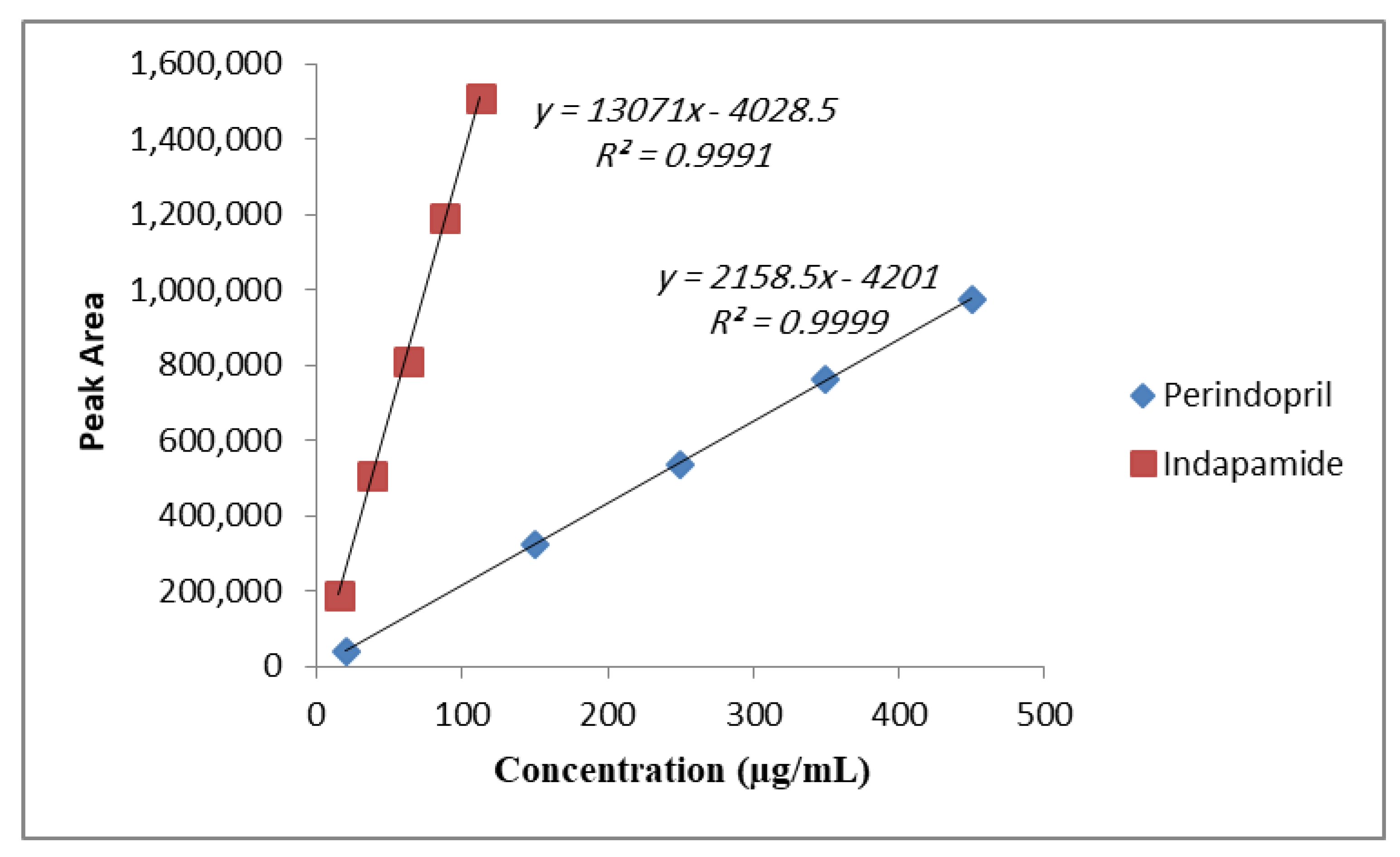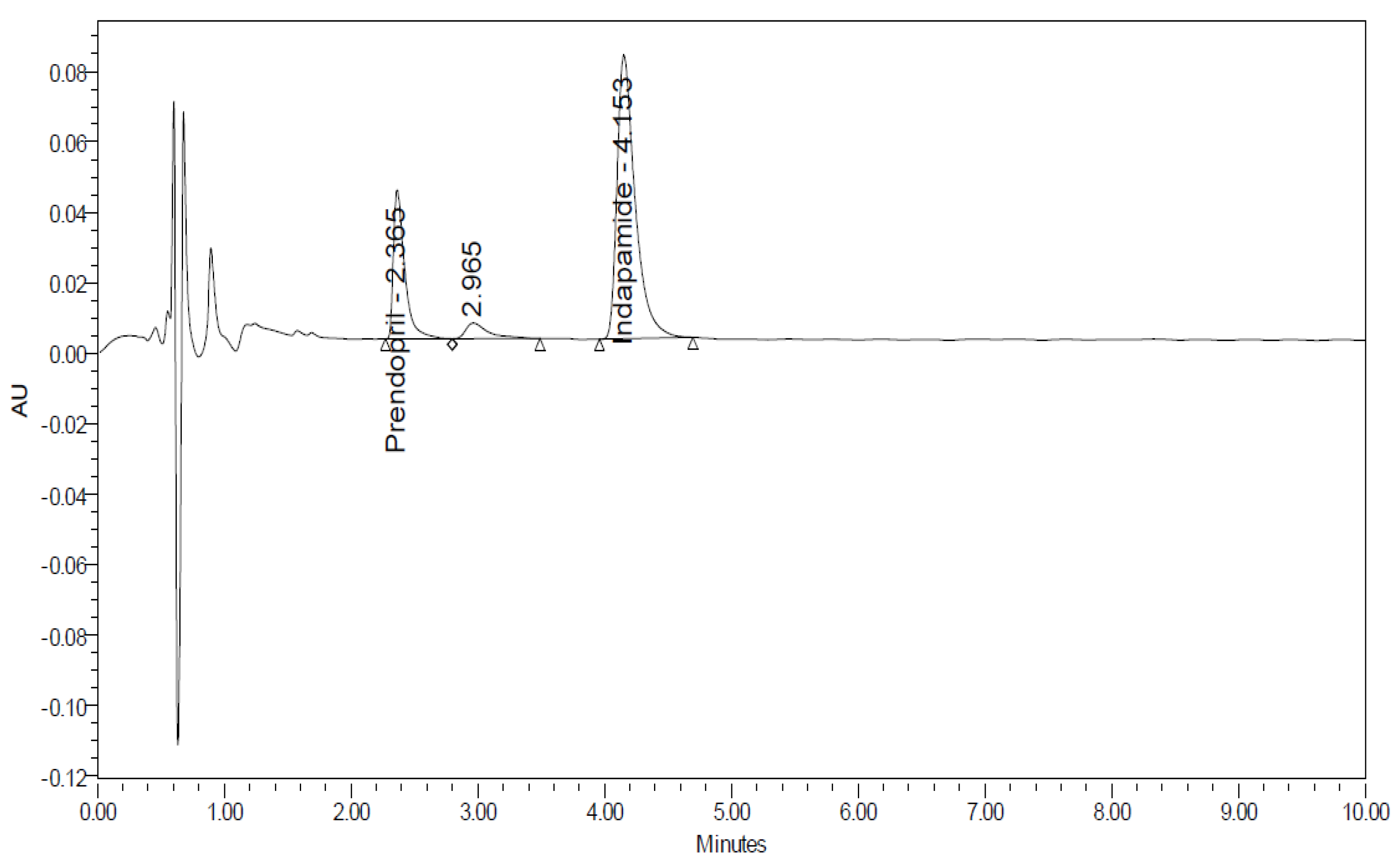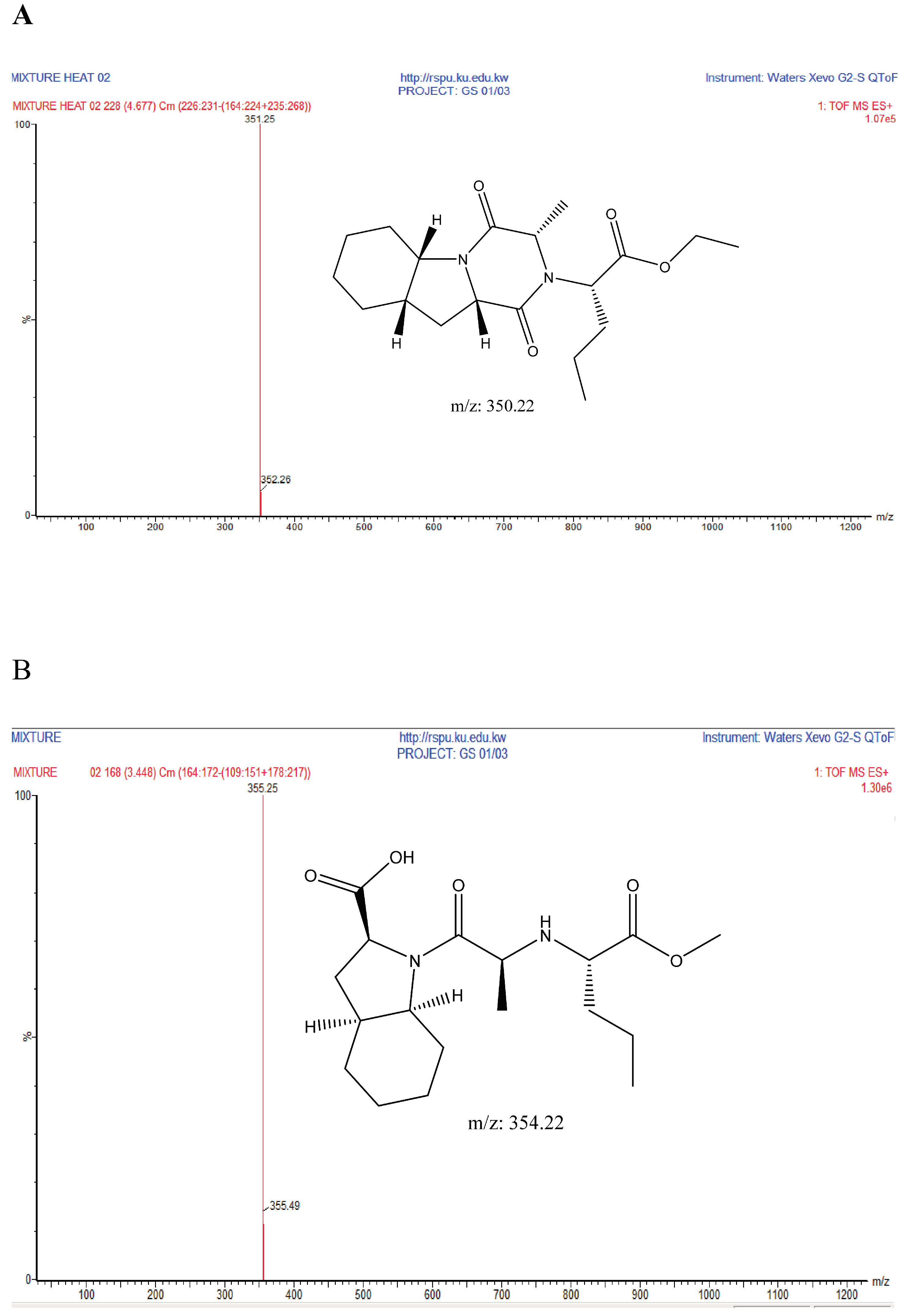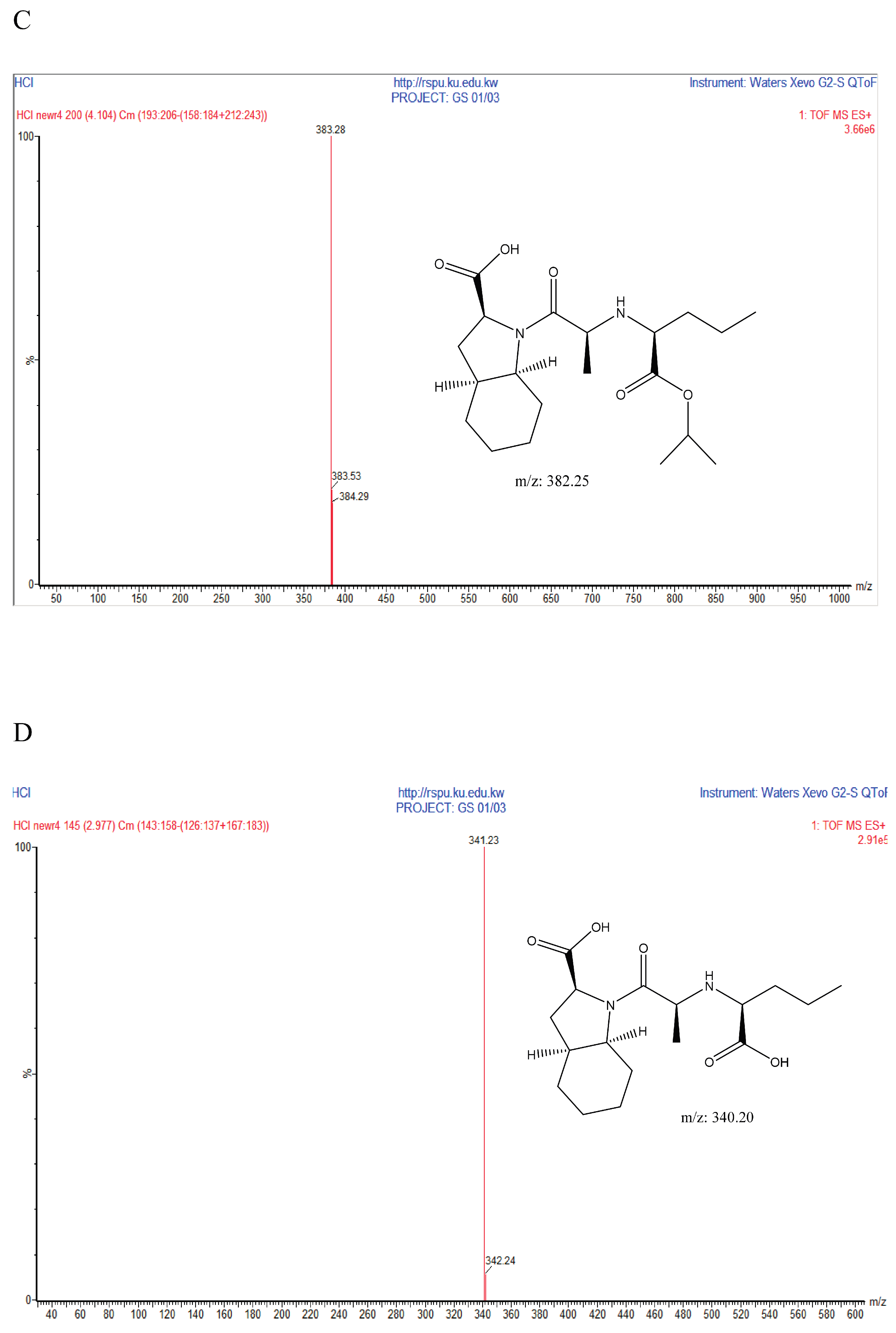UHPLC-UV Method for Simultaneous Determination of Perindopril Arginine and Indapamide Hemihydrate in Combined Dosage Form: A Stability-Indicating Assay Method
Abstract
:1. Introduction
2. Materials and Methods
2.1. Materials
2.2. Instruments
2.2.1. UHPLC Instrumentation
2.2.2. Liquid Chromatography–Mass Spectrometry (LC-MS)
2.3. Chromatographic Conditions
2.4. Standard Solutions of Perindopril Arginine and Indapamide Hemihydrate
2.5. Validation
2.5.1. System Suitability Test
2.5.2. Linearity and Calibration Curves
2.5.3. Accuracy
2.5.4. Precision
2.5.5. Limit of Detection (LOD) and Limit of Quantification (LOQ)
2.6. Application to Pharmaceutical Formulation
2.7. Forced Degradation Studies
2.7.1. Acidic Degradation
2.7.2. Basic Degradation
2.7.3. Thermal Degradation
3. Results and Discussion
3.1. Method Development
3.2. Calibration Curves
3.3. Accuracy and Precision
3.4. Limit of Quantification and Limit of Detection
3.5. Estimation of Perindopril Arginine and Indapamide Hemihydrate in Coversyl Plus®
3.6. Stability Study
4. Conclusions
Acknowledgments
Conflicts of Interest
References
- Nedogoda, S.; Stojanov, V. Single-pill combination of perindopril/indapamide/amlodipine in patients with uncontrolled hypertension: A randomized controlled trial. Cardiol. Ther. 2017, 6, 91–104. [Google Scholar] [CrossRef] [PubMed]
- Mancia, G.; Fagard, R.; Narkiewicz, K.; Redon, J.; Zanchetti, A.; Böhm, M.; Christiaens, T.; Cifkova, R.; de Backer, G.; Dominiczak, A.; et al. 2013 ESH/ESC Guidelines for the management of arterial hypertension: The Task Force for the management of arterial hypertension of the European Society of Hypertension (ESH) and of the European Society of Cardiology (ESC). J. Hypertens. 2013, 31, 1281–1357. [Google Scholar] [CrossRef] [PubMed]
- Todd, P.A.; Fitton, A. Perindopril. Drugs 1991, 42, 90–114. [Google Scholar] [CrossRef] [PubMed]
- Chaffman, M.; Heel, R.; Brogden, R.; Speight, T.; Avery, G. Indapamide. Drugs 1984, 28, 189–235. [Google Scholar] [CrossRef] [PubMed]
- de Leeuw, P. Very-low-dose combination of perindopril and indapamide as a novel strategy in first-line management of hypertension. J. Hypertens. Suppl. 2001, 19, S41–S45. [Google Scholar] [PubMed]
- Mourad, J.; Waeber, B.; Zannad, F.; Laville, M.; Duru, G.; Andréjak, M. Comparison of different therapeutic strategies in hypertension: A low-dose combination of perindopril/indapamide versus a sequential monotherapy or a stepped-care approach. J. Hypertens. 2004, 22, 2379–2386. [Google Scholar] [CrossRef] [PubMed]
- de Leeuw, P. Combination perindopril/indapamide for the treatment of hypertension: A review. Expert Opin. Pharmacother. 2011, 12, 1827–1833. [Google Scholar] [CrossRef] [PubMed]
- Croom, K.; Kassianos, G.; Schachter, M.; Morell, J.; Gaw, A.; Kirby, M.; Tamargo, J.; Yawn, B.; Yawn, R.; Barakat, K.; et al. Coversyl Plus—Treating hypertension and improving clinical outcomes in T2D and other high risk groups. Drugs Context 2008, 4, 71–84. [Google Scholar] [CrossRef]
- British Pharmacopoeia Commission. British Pharmacopoeia; TSO: London, UK, 2007; Volume II, pp. 1609–1611. [Google Scholar]
- British Pharmacopoeia Commission. British Pharmacopoeia; TSO: London, UK, 2007; Volume I, pp. 1078–1080. [Google Scholar]
- United States Pharmacopeial Convention. U.S. Pharmacopeia-30–National Formulary-25, Asian ed.; United States Pharmacopeial Convention, Inc.: Rockville, MD, USA, 2007; Volume II, p. 2340. [Google Scholar]
- Abdellatef, H. Utility of certain π-acceptors for the spectrophotometric determination of perindopril. J. Pharm. Biomed. Anal. 1998, 17, 1267–1271. [Google Scholar] [CrossRef]
- Abdellatef, H.; Ayad, M.; Taha, E. Spectrophotometric and atomic absorption spectrometric determination of ramipril and perindopril through ternary complex formation with eosin and Cu (II). J. Pharm. Biomed. Anal. 1999, 18, 1021–1027. [Google Scholar] [CrossRef]
- Lin, S.J.; Wu, H.L.; Chen, S.H.; Wen, Y.H. Derivatization-GAS chromatographic determination of perindopril. Anal. Lett. 1996, 29, 1751–1762. [Google Scholar] [CrossRef]
- Simončič, Z.; Roškar, R.; Gartner, A.; Kogej, K.; Kmetec, V. The use of microcalorimetry and HPLC for the determination of degradation kinetics and thermodynamic parameters of Perindopril Erbumine in aqueous solutions. Int. J. Pharm. 2008, 356, 200–205. [Google Scholar] [CrossRef] [PubMed]
- Rani, P.; Sekaran, B. A validated RP-HPLC method for the determination of Perindopril Erbumine in pharmaceutical formulations. Int. J. PharmTech Res. 2009, 1, 575–578. [Google Scholar]
- Saleh, H.M.; Amin, A.S.; El-Mammli, M. New Colorimetric methods for the determination of Indapamide and its Formulations. J. Mikrochim. Acta 2001, 137, 185–189. [Google Scholar] [CrossRef]
- Tarkase Kailash, N.; Jadhav Manisha, B.; Tajane Sachin, R.; Dongare Umesh, S. Development and validation of UV-Spectrophotometric methods for estimation of Indapamide in bulk and tablet dosage form. Der Pharma Chem. 2012, 4, 1128–1132. [Google Scholar]
- Pannu, H.; Mahajan, M.; Sawant, S. Validated RP-HPLC method for the determination of indapamide in bulk and tablet dosage form. Der Pharma Chem. 2012, 4, 996–1002. [Google Scholar]
- Legorburu, M.; Alonso, R.; Jimenez, R.; Ortiz, E. Quantitative determination of indapamide in pharmaceuticals and urine by high-performance liquid chromatography with amperometric detection. J. Chromatogr. Sci. 1999, 37, 283–287. [Google Scholar] [CrossRef] [PubMed]
- Hang, T.; Zhao, W.; Liu, J.; Song, M.; Xie, Y.; Zhang, Z.; Shen, J.; Zhang, Y. A selective HPLC method for the determination of indapamide in human whole blood: Application to a bioequivalence study in Chinese volunteers. J. Pharm. Biomed. Anal. 2006, 40, 202–205. [Google Scholar] [CrossRef] [PubMed]
- Gao, X.; Chen, J.; Mei, N.; Tao, W.; Jiang, W.; Jiang, X. HPLC determination and pharmacokinetic study of indapamide in human whole blood. Chromatographia 2005, 61, 581–585. [Google Scholar] [CrossRef]
- Dewani, M.; Bothara, K.; Madgulkar, A.; Damle, M. Simultaneous estimation of perindopril erbumine and indapamide in bulk drug and tablet dosage form by HPTLC. Int. J. Compr. Pharm. 2011, 2, 1–4. [Google Scholar]
- Modi, D.K.; Patel, C.N. Development and Validation of Spectrophotometric Method for Simultaneous Estimation of Perindopril and Indapamide in Combined Dosage Form by Simultaneous Equation Method. Int. J. PharmTech Res. 2010, 2, 411–416. [Google Scholar]
- Erk, N. Comparison of spectrophotometric and an LC method for the determination perindopril and indapamide in pharmaceutical formulations. J. Pharm. Biomed. Anal. 2001, 26, 43–52. [Google Scholar] [CrossRef]
- Jogia, H.; Khandelwal, U.; Gandhi, T.; Singh, S.; Modi, D. Development and validation of a stability-indicating assay method for simultaneous determination of perindopril and indapamide in combined dosage form by reversed-phase high-performance liquid chromatography. J. AOAC Int. 2010, 93, 108–115. [Google Scholar] [PubMed]
- ICH. Validation of Analytical Procedures: Text and Methodology Q2(R1). International Conference on Harmonization. 2005. Geneva. Available online: http://www.ich.org (accessed on 17 August 2017).
- Szabó, Z.; Réti, Z.; Gagyi, L.; Kis, E.; Sipos, E. Simultaneous Quantification of Related Substances of Perindopril Tert-Butylamine Using a Novel Stability Indicating Liquid Chromatographic Method. J. Chromatogr. Sci. 2015, 53, 424–430. [Google Scholar] [CrossRef] [PubMed]







| Parameters | Perindopril Arginine | Indapamide Hemihydrate | Reference Value |
|---|---|---|---|
| Resolution (Rs) | 3.584 | 3.584 | Rs ≥ 2 |
| Tailing factor (T) | 1.55 | 1.81 | T ≤ 2 |
| Capacity factor (K’) | 2.64 | 5.39 | 1< K’<10 |
| Selectivity (α) | 2.05 | 2.05 | α > 1 |
| Asymmetry factor (Af) | 1.04 | 1.1 | 0.9 < Af < 1.1 |
| Theoretical plates (N) | 2268 | 15955 | N > 2000 |
| Height equivalent to theoretical plate (HETP; cm plate−1) | 0.002 | 0.0003 | The smaller the value, the higher the column efficiency |
| Parameters | Perindopril | Indapamide |
|---|---|---|
| Range µg/mL | 20–450 | 15–112.5 |
| Regression Equation | y = 2158.5x − 4201 | y = 13071x − 4028.5 |
| Correlation coefficient (r) | 0.9999 | 0.9991 |
| LOQ (µg/mL) | 20 | 15 |
| LOD (µg/mL) | 6.7 | 5 |
| Recovery of Pharmaceutical preparation a | 99.81% ± 0.63 | 99.72% ± 0.84 |
| Intra-assay precision b | 1.7 | 1.6 |
| Inter-assay precision b | 1.9 | 1.8 |
| Accuracy c | 97.20% | 94.20% |
| Perindopril Concentration μg/mL | Mean ± SD (n = 3) Observed/μg/mL | Precision a (%) | Accuracy b (%) | Indapamide Concentration μg/mL | Mean ± SD (n = 3) Observed/μg/mL | Precision a (%) | Accuracy b (%) |
|---|---|---|---|---|---|---|---|
| 20 | 19.44 ± 0.331 | 1.7 | 97.20 | 15 | 14.13 ± 0.223 | 1.6 | 94.20 |
| 250 | 247.14±1.449 | 0.6 | 98.80 | 62.5 | 61.03 ± 0.601 | 1.0 | 97.64 |
| 450 | 441.67 ± 2.044 | 0.5 | 98.14 | 112.5 | 111.26 ± 0.86 | 0.8 | 98.89 |
| Perindopril Concentration μg/mL | Mean ± SD (n = 3) Observed/μg/mL | Precision a (%) | Accuracy b (%) | Indapamide Concentration μg/mL | Mean ± SD (n = 3) Observed/μg/mL | Precision a (%) | Accuracy b (%) |
|---|---|---|---|---|---|---|---|
| 20 | 19.26 ± 0.373 | 1.9 | 96.30 | 15 | 13.88 ± 0.255 | 1.8 | 92.53 |
| 250 | 244.36 ± 1.886 | 0.8 | 97.74 | 62.5 | 58.97± 0.713 | 1.2 | 94.35 |
| 450 | 438.93 ± 2.453 | 0.6 | 97.54 | 112.5 | 109.91 ± 0.952 | 0.9 | 97.69 |
© 2018 by the author. Licensee MDPI, Basel, Switzerland. This article is an open access article distributed under the terms and conditions of the Creative Commons Attribution (CC BY) license (http://creativecommons.org/licenses/by/4.0/).
Share and Cite
Al-Tannak, N.F. UHPLC-UV Method for Simultaneous Determination of Perindopril Arginine and Indapamide Hemihydrate in Combined Dosage Form: A Stability-Indicating Assay Method. Sci. Pharm. 2018, 86, 7. https://doi.org/10.3390/scipharm86010007
Al-Tannak NF. UHPLC-UV Method for Simultaneous Determination of Perindopril Arginine and Indapamide Hemihydrate in Combined Dosage Form: A Stability-Indicating Assay Method. Scientia Pharmaceutica. 2018; 86(1):7. https://doi.org/10.3390/scipharm86010007
Chicago/Turabian StyleAl-Tannak, Naser F. 2018. "UHPLC-UV Method for Simultaneous Determination of Perindopril Arginine and Indapamide Hemihydrate in Combined Dosage Form: A Stability-Indicating Assay Method" Scientia Pharmaceutica 86, no. 1: 7. https://doi.org/10.3390/scipharm86010007






